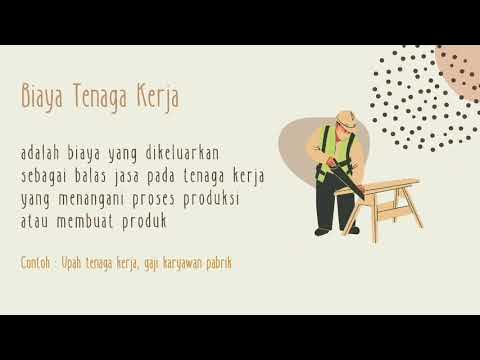Cost Terms and Concepts in Cost & Management Accounting Part 2, Manufacturing Costs, Mike Werner
Summary
TLDRIn this video, Mike Werner explores the key components of manufacturing costs, including direct material costs, direct labor costs, and manufacturing overhead. He explains how these costs are traced, allocated, and classified in the manufacturing process, and introduces inventory classifications such as raw material, work-in-process, and finished goods. The video covers the cost flow for manufacturers, cost of goods manufactured, and the cost of goods sold schedule, emphasizing how these are used in financial statements. Ultimately, it provides a comprehensive understanding of the essential cost terms and processes in manufacturing accounting.
Takeaways
- 😀 Direct material costs include raw materials like steel, plastic, glass, and tires that can be easily traced to a product. Indirect materials, such as glue or tape, are part of manufacturing overhead.
- 😀 Direct labor costs refer to the wages of workers who directly touch the product during manufacturing, like assembly line workers. Indirect labor costs include workers like security guards and janitors.
- 😀 Manufacturing overhead includes all indirect manufacturing costs like factory rent, utilities, insurance, and factory depreciation, but excludes administrative and sales office costs.
- 😀 Manufacturing overhead is an indirect cost and must be allocated using methods like traditional overhead allocation or activity-based costing.
- 😀 Traditional manufacturing overhead allocation pools all overhead costs and allocates them based on factors like direct labor hours or machine hours.
- 😀 Activity-based costing (ABC) is a more accurate method that uses multiple overhead cost pools, allocating costs based on activities like equipment setups or material handling.
- 😀 Prime cost is the sum of direct material and direct labor costs, excluding manufacturing overhead, while conversion cost includes direct labor and manufacturing overhead.
- 😀 Manufacturers classify their inventory into raw materials, work-in-process, and finished goods, with raw materials being unused materials, work-in-process being partially completed goods, and finished goods being ready for sale.
- 😀 The cost flow for a manufacturer moves from raw material inventory to work-in-process inventory as products are made, and finally to finished goods inventory when the products are completed.
- 😀 The cost of goods manufactured schedule outlines the costs incurred in manufacturing products, including direct materials, direct labor, and manufacturing overhead. It also accounts for beginning and ending work-in-process inventories.
- 😀 In the cost of goods sold schedule, manufacturers substitute purchases with the cost of goods manufactured, which is used to determine the cost of goods sold by adjusting for beginning and ending inventories.
Q & A
What are the main components of manufacturing costs?
-The main components of manufacturing costs include direct material costs, direct labor costs, and manufacturing overhead costs.
What is the difference between direct material and indirect material?
-Direct material costs can be traced directly to a unit of product, while indirect materials, such as ink, glue, and tape, are difficult to trace to individual units and are considered part of manufacturing overhead.
What does direct labor cost refer to?
-Direct labor cost refers to the cost of production labor that can be directly traced to individual units of product, such as the wages of assembly line workers.
What is the distinction between direct labor and indirect labor?
-Direct labor is the labor directly involved in manufacturing the product, while indirect labor includes workers like security guards, janitors, and maintenance workers, who support production but aren't directly involved with manufacturing.
What costs are included under manufacturing overhead?
-Manufacturing overhead includes all costs associated with manufacturing products other than direct material and direct labor. This includes indirect materials, indirect labor, factory rent, utilities, insurance, taxes, and depreciation.
How is manufacturing overhead allocated to products?
-Manufacturing overhead is allocated to products using either traditional overhead allocation, where costs are pooled and allocated based on labor hours or machine hours, or activity-based costing (ABC), where costs are assigned based on specific activities and cost drivers.
What is the main advantage of activity-based costing over traditional overhead allocation?
-Activity-based costing (ABC) is more accurate as it allocates overhead costs based on activities that cause the cost, but it is more complex and costly to implement compared to traditional allocation methods.
What is the difference between prime cost and conversion cost?
-Prime cost includes direct material and direct labor costs, while conversion cost includes direct labor and manufacturing overhead costs. Conversion cost refers to the costs required to convert raw materials into finished products.
What are the three types of inventory classifications for manufacturers?
-Manufacturers typically have three types of inventory: raw material inventory (materials on hand but not yet used in production), work-in-process inventory (products still in production), and finished goods inventory (completed products ready for sale).
How does raw material move through the inventory system of a manufacturer?
-Raw material starts in raw material inventory. As it's used in production, it's transferred to work-in-process inventory. Once production is complete, the product moves to finished goods inventory, and when sold, its cost is transferred to cost of goods sold.
Outlines

This section is available to paid users only. Please upgrade to access this part.
Upgrade NowMindmap

This section is available to paid users only. Please upgrade to access this part.
Upgrade NowKeywords

This section is available to paid users only. Please upgrade to access this part.
Upgrade NowHighlights

This section is available to paid users only. Please upgrade to access this part.
Upgrade NowTranscripts

This section is available to paid users only. Please upgrade to access this part.
Upgrade NowBrowse More Related Video

Akuntansi untuk Tenaga Kerja part 1

Menghitung Harga Pokok Produksi - Part 1

(FACIL) Materiales Directos, Mano de Obra Directa, Costos Indirectos de Fábrica

Biaya Produksi | Biaya Non Produksi | Menganalisis Biaya Prototype Produk Barang/Jasa

Cost Accounting Overview

Variable Costing vs Absorption Costing
5.0 / 5 (0 votes)